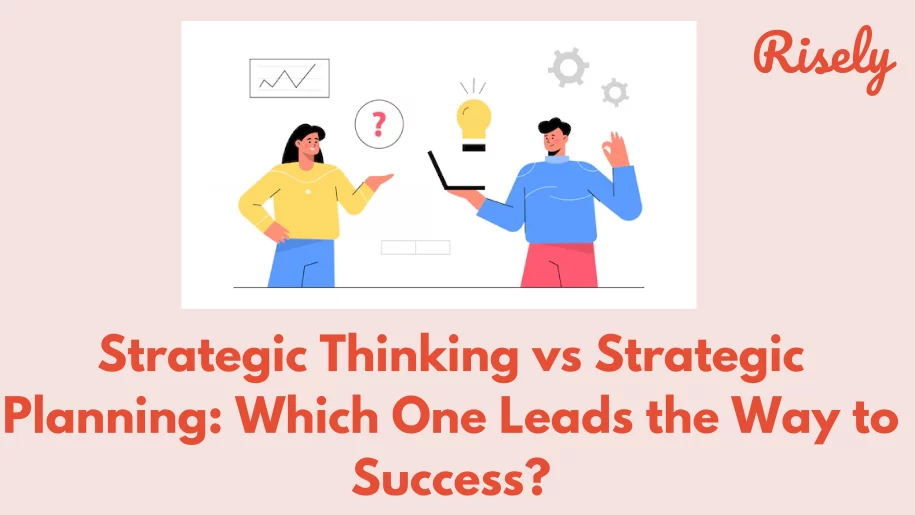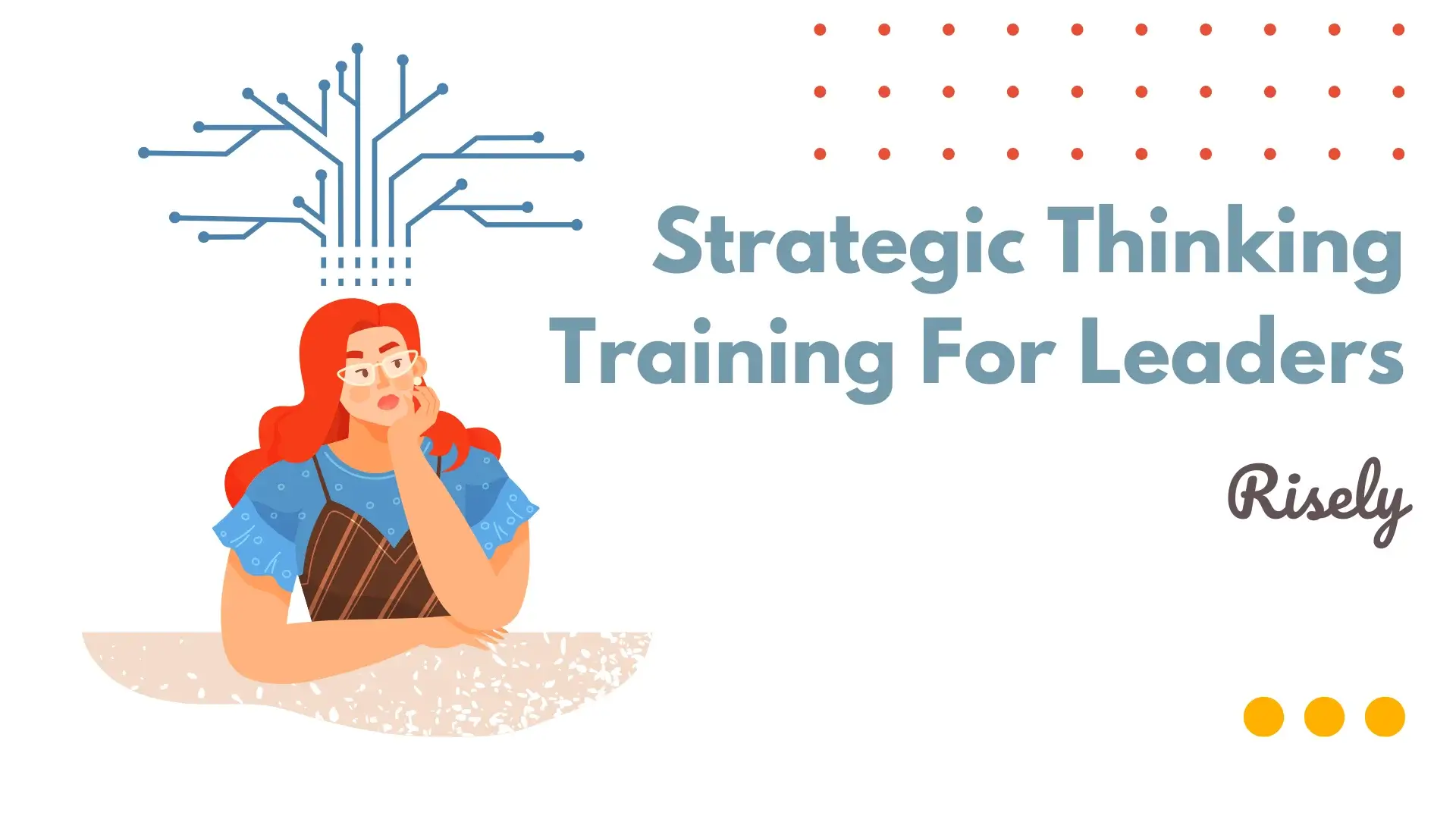Strategic Thinking vs Strategic Planning: Which One Leads the Way to Success?
Welcome to our blog, where we will explore strategic thinking and planning. While these two terms are often used interchangeably, they represent different aspects of the strategic management process. Strategic thinking involves analyzing complex situations, identifying problems, and developing long-term plans to achieve specific goals. On the other hand, strategic planning consists of creating a detailed roadmap or action plan to achieve an organization’s strategic goals. In this blog, we will define strategic thinking and planning, highlight the key differences between the two, and outline the steps involved in the strategic planning process. By the end of this blog, you will clearly understand strategic thinking and planning and how they work together to achieve organizational success.What Is Strategic Thinking?
Strategic thinking is analyzing complex situations, identifying the underlying problems, and developing a long-term plan of action to achieve specific goals. It involves seeing the big picture, understanding how various factors and variables interact and anticipating future trends and challenges. Strategic thinking requires analytical, creative, and critical thinking skills. It involves considering multiple options and evaluating their potential outcomes, risks, and benefits. It also involves being proactive and taking a proactive approach to problem-solving rather than just reacting to situations as they arise.What is Strategic Planning?
Strategic planning is a process that involves defining an organization’s long-term objectives, identifying the resources required to achieve those objectives, and developing a plan of action to use those resources effectively. It is a systematic approach to aligning an organization’s goals with its resources, capabilities, and environment. Strategic planning involves analyzing the internal and external environment to identify strengths, weaknesses, opportunities, and threats (SWOT analysis). This analysis helps an organization understand its current position and identify the opportunities and challenges it faces.Strategic thinking vs strategic planning
While strategic thinking and planning can seem a bit related, they refer to different aspects of the strategic management process. Strategic thinking is a mindset or cognitive process that involves analyzing complex situations, identifying underlying problems, and developing a long-term plan of action to achieve specific goals. It consists of seeing the big picture, anticipating future trends and challenges, and thinking creatively about potential solutions. Strategic thinking is a more abstract, high-level activity focusing on developing an organization’s vision, mission, and goal-setting. Strategic Thinking Examples:- A company CEO looking to expand business in a new market will use strategic thinking. They will analyze the market, consider the competition, and identify potential opportunities and risks. They will then develop a long-term plan of action to enter the market successfully.
- A nonprofit organization that wants to increase its impact on a specific social issue will engage in strategic thinking. They will analyze the problem, consider the stakeholders, and identify potential solutions. They will then develop a long-term plan of action to achieve their mission.
- A government agency that wants to improve its services to citizens will engage in strategic thinking. They will analyze the current system, consider the needs of citizens, and identify potential improvements. They will then develop a long-term plan of action to implement those improvements.
- A company that wants to launch a new product will engage in strategic planning. They will identify the resources required, set priorities, and establish metrics for measuring success. They will then develop a detailed roadmap or action plan to successfully bring the product to market.
- A nonprofit organization that wants to increase its fundraising efforts will engage in strategic planning. They will identify the resources required, set priorities, and establish metrics for measuring success. They will then develop a detailed plan of action to achieve their fundraising goals.
- A government agency that wants to improve its cybersecurity capabilities will engage in strategic planning. They will identify the resources required, set priorities, and establish metrics for measuring success. They will then develop a detailed plan of action to implement the necessary improvements to their cybersecurity infrastructure.
Other Interesting Reads
What are the 7 Steps in Strategic Planning?
Strategic planning steps may vary depending on the organization’s size, industry, and specific needs. However, the following points explain what are the 7 steps of strategic planning:- Establishing the Mission and Vision: The first step in strategic planning is establishing the organization’s mission and vision. This involves defining the organization’s purpose, values, and goals.
- Conducting a SWOT Analysis: The second step is to conduct a SWOT analysis (Strengths, Weaknesses, Opportunities, and Threats). This helps to identify the organization’s internal strengths and weaknesses, as well as external opportunities and threats.
- Setting Objectives: Based on the SWOT analysis, the organization can set specific, measurable, achievable, relevant, and time-bound (SMART) objectives.
- Developing Strategies: With the objectives in mind, the organization can develop strategies to achieve them. This involves identifying and evaluating different options, considering available resources, and selecting the most appropriate action.
- Allocating Resources: Once the strategies are in place, the organization must allocate resources to implement them effectively. This involves identifying the necessary financial, human, and physical resources and ensuring they are available.
- Developing Implementation Plans: The next step is to create detailed implementation plans for each strategy. This involves identifying specific tasks, timelines, responsibilities, and performance measures.
- Monitoring and Evaluation: Finally, the organization needs to monitor and evaluate the implementation of the strategies to ensure they are achieving the desired outcomes. This involves tracking progress, reviewing performance measures, and adjusting as needed to stay on track.
Conclusion
In conclusion, strategic thinking and planning are two critical components of the strategic management process. While strategic thinking and planning represent different aspects of the process, they are interconnected and must work together to achieve organizational success. Strategic thinking involves analyzing complex situations, identifying opportunities and risks, and developing long-term plans to achieve specific goals. On the other hand, strategic planning consists of creating a detailed roadmap or action plan to achieve an organization’s strategic goals. By following the steps outlined in the strategic planning process, organizations can develop a clear and actionable strategic plan that aligns with their long-term goals and objectives. Understanding strategic thinking vs strategic planning is essential for organizations navigating complex environments and achieving long-term success. By leveraging strategic thinking and planning, organizations can position themselves for success and stay ahead of the competition.Test your communication skills now to become an effective collaborator with teams
Get detailed insights delivered straight to your inbox in just a few minutes.
FAQs
What is the difference between thinking and planning?
Thinking and planning are two distinct cognitive processes that involve different mental activities and outcomes. The main difference between thinking and planning is that thinking is a more general and creative process that generates ideas and possibilities. In contrast, planning is a more structured and organized process that defines specific actions and timelines to achieve a particular goal. In other words, thinking is about generating ideas and possibilities, while planning is about converting those ideas into a tangible action plan. While thinking and planning are distinct cognitive processes, they are interconnected and often combined to achieve specific goals and objectives.
What comes first, strategy or planning?
Strategy and planning are interdependent and iterative in the strategic management process. Both are essential components of the process, but strategy comes first. Without a clear and well-defined strategy, planning becomes an exercise in futility. A solid strategy provides a foundation for effective planning by outlining the goals, objectives, and approaches that the organization will use to achieve its desired outcomes. Planning then turns the strategy into a tangible action plan that can be implemented and monitored to ensure progress toward the desired results.
What are the three levels of strategic planning?
The three levels of strategic planning are:
– Corporate-level strategy: This level of strategic planning focuses on the overall direction and scope of the entire organization.
– Business-level strategy: This level of strategic planning focuses on individual business units or product lines within the organization.
– Functional-level strategy: This level of strategic planning focuses on specific functional areas within the organization, such as finance, marketing, operations, and human resources.
Each level of strategic planning is interdependent and contributes to the organization’s overall success. By aligning the three levels of strategic planning, organizations can effectively navigate complex environments, achieve their long-term goals, and stay ahead of the competition.
– Corporate-level strategy: This level of strategic planning focuses on the overall direction and scope of the entire organization.
– Business-level strategy: This level of strategic planning focuses on individual business units or product lines within the organization.
– Functional-level strategy: This level of strategic planning focuses on specific functional areas within the organization, such as finance, marketing, operations, and human resources.
Each level of strategic planning is interdependent and contributes to the organization’s overall success. By aligning the three levels of strategic planning, organizations can effectively navigate complex environments, achieve their long-term goals, and stay ahead of the competition.
Who is responsible for strategic thinking?
In an organization, strategic thinking is typically the responsibility of top-level executives, such as the CEO, CMO, COO, and CFO. These executives are responsible for setting the overall direction and vision for the organization and making strategic decisions that align with the organization’s goals and objectives. However, strategic thinking is not limited to top-level executives. Employees at all levels of the organization can contribute to strategic thinking by identifying opportunities, suggesting improvements, and providing feedback on current strategies.
Other Related Blogs
Strategic Thinking Training For Leaders Simplified
Strategic Thinking Training For Leaders Simplified Strategic thinking is a vital skill for business leaders, managers, and employees in today’s fast-paced, competitive world. It goes beyond day-to-day tasks and involves…
10 Best Strategic Thinking Coaches to Speed Up Your Growth
10 Best Strategic Thinking Coaches to Speed Up Your Growth In the fast-paced and ever-evolving business landscape, strategic thinking has become more than just a desirable trait; it’s a critical…
5 Powerful Skills to Become an Exceptional Business Leadership Coach
5 Powerful Skills to Become an Exceptional Business Leadership Coach In the world of business, leadership is of paramount importance. It is something that makes all the difference. With so…
8 Strategic Thinking Examples to Help You Succeed
Strategic thinking is an essential skill that leaders and managers must possess to steer their teams toward success. It involves analyzing situations, identifying opportunities and risks, and developing innovative solutions…


